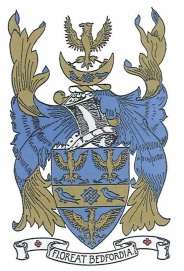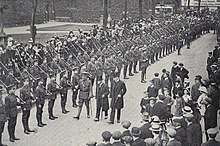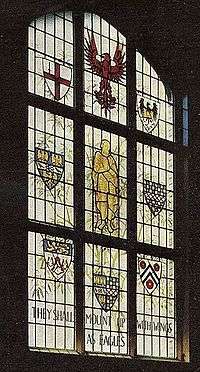Bedford Modern School
Bedford Modern School (often called BMS) is a Headmasters' and Headmistresses' Conference independent school in Bedford, England.[1] The school has its origins in The Harpur Trust, born from the endowments left by Sir William Harpur in the sixteenth century.[2] BMS comprises a junior school (ages 6–11) and a senior school (ages 11–18).[1]
| Bedford Modern School | |
|---|---|
 | |
| Address | |
Manton Lane , , MK41 7NT England | |
| Information | |
| Type | Public School and Independent day school |
| Motto | Floreat Bedfordia (May Bedford Flourish) |
| Religious affiliation(s) | Interdenominational |
| Established | 1764 |
| Department for Education URN | 109728 Tables |
| Ofsted | Reports |
| Chair | Sally Peck |
| Headmaster | Alex Tate |
| Gender | Coeducational |
| Age | 7 to 18 |
| Enrolment | 1207 |
| Colour(s) | Black and Red |
| Publication | The Eagle/ The Sports Eagle/ The Eaglet |
| School Song | "School of the Black and Red" |
| Boat Club | Bedford Modern School Boat Club |
| Former pupils | Old Bedford Modernians www |
| Unofficial Motto | "Modern 'til I Die" |
| Website | www |
The school has had four names.[2] In 1873 the school became Bedford Modern School to reflect its modern curriculum, providing an education for the professions.[2] BMS provided education not only for the locality but also for colonial and military personnel abroad, seeking good education for their young families.[2]
History
Bedford Modern School has its origins in The Harpur Trust, born from the endowments left by Sir William Harpur in the sixteenth century.[3] Since the separation of Bedford School and BMS in 1764, the School has had four names – the Writing School, the English School, the Commercial School and finally Bedford Modern School, the last change being made in 1873 to reflect the School's modern curriculum, providing an education for the professions.[2]

BMS provided education not only for the locality but also for colonial and military personnel seeking good education for their young families.[2] In 1834 BMS moved to buildings designed by Edward Blore in Harpur Square, Bedford.[2]
The ‘Long Swim’ was established under Dr Poole (headmaster 1877-1900), a ‘free-for-all’ swimming race in the River Great Ouse from Bedford town bridge to the ‘Suspension Bridge’. The gruelling event was stopped in 1957 due to river pollution.[2] An annual compulsory steeplechase still takes place at the school for each year group.[4]
During World War II, the inventors Cecil Vandepeer Clarke and Stuart Macrae took a prototype of their limpet mine to Bedford Modern School swimming baths, which were closed for such occasions. Clarke was an excellent swimmer and was able to propel himself through the water with a prototype bomb attached to a keeper plate on webbing around his waist.[5]

Dame Alice Owen's School was evacuated to BMS for the entire duration of World War II.[2][6]
The school’s Prichard Museum, a collection of artefacts sent back to the school mainly from old boys around the world, became Bedford Museum.[2] George Witt was a major benefactor to the school's museum.[7]
The successful growth of the school meant that the buildings became increasingly cramped and in 1974 the school moved to new premises in Bedford.[2] The Foundation Stone for the new building was laid by Margaret Thatcher.[2] On 11 May 1976, Her Majesty Queen Elizabeth II unveiled a commemorative panel at the new school building during her visit with Prince Philip, Duke of Edinburgh.[2]
BMS became a coeducational day school in 2003. In 2014, BMS celebrated the 250th anniversary of its separation from Bedford School.[4] David Scott Daniell (OBM) wrote about his schooldays at BMS in his first novel, Young English.[8][9]
School houses
| House name and Colour[4] | |
|---|---|
| Bell | |
| Farrar | |
| Mobbs | |
| Oatley | |
| Rose | |
| Tilden | |
Following a tradition of over a hundred years the Senior School Houses of BMS were: North, South, East, West, County and United Boarders.[2] United Boarders comprised the combined boarding houses: Culver, Shakespeare, and School House.[2] The day boy houses often, though not always, reflected the parts of the town or county from which the boys hailed and were mentioned in the chorus of the school song.[2]
A decision was made in October 1997 for the House system to play a more central role in the School and to reinvigorate internal competition whilst upholding its traditions.[4] Six Heads of House were appointed from the staff under the direction of a Senior Head of House, with the brief to establish a modern House system to be integrated into a new school structure and working week, beginning in September 1998.[4] A competition was launched to establish the new house names. The Houses were named in honour of six Old Bedford Modernians who had gained national or international recognition in their field.[4]
Each house has its own tie which consists of stripes of the three school colours and their own house colour.[4] Inter-house sports cover all major and minor sports run by the school, at both Junior and Senior level, and range from rugby and hockey (major sports) to shooting and fencing (minor sports).[4] There are also non-sporting events such as quizzes and Music and Drama competitions.[4] Students take leadership roles as House Captain or House Deputies.[4]
Monitors

Monitors are selected, following a written application process, from students in the Upper Sixth.[4] Each team of monitors works with a specific year group, and are led by two Senior Monitors, appointed by the Head Master.[4] Senior Monitors, along with the Heads of School, are entitled to wear a red trim on their blazer.[4]
Uniform
Boys in years 7 to 11 wear their house tie and school blazer alongside black trousers and a white shirt.[4] Girls may wear the school skirt or black trousers with the school blazer (girls' blazers have a red and black braid). Sixth form students wear a business suit.[4]
Coeducation
Until 2003, BMS was a day and boarding school for boys.[4] Following 12 years of discussions, Bedford Modern School closed its boarding houses and became coeducational in September 2003.[4] In 2013, BMS celebrated 10 years of coeducation, with a play written by Mark Burgess commissioned to celebrate the event.
Extracurricular activities
Sport


BMS competes against Bedford School, Berkhamsted School, Bishop's Stortford College, Eton College, Hampton School, Harrow School, Kimbolton School, Haileybury, Merchant Taylors, Oakham School, Oundle School, St Albans School, Stowe School and Stamford School in rugby union or rowing. Other sports include cricket, hockey, athletics, fencing, rugby fives, football, swimming, table tennis, tennis and water polo.
Bedford Modern has had former students going on to compete at national and international levels including two former Captains of the England Rugby Team and a former Captain of the England cricket team:
- Olympians: Major-General Charles Howard Foulkes CB CMG DSO (field hockey Bronze), John Yallop (Rowing Silver), Tim Foster MBE (Rowing Gold), Thomas Hammond (track and field), Sir Sidney Abrahams (long jump), Hamilton Milton (swimming), Peter Knapp (rowing), John Yallop (rowing), Neil Keron (rowing), Rod Chisholm (rowing)
- Paralympian: Julie Rogers
- England Rugby Caps: Horace Finlinson, WB Thomson, Edgar Mobbs (Captain), Arthur Gilbert Bull, Dick Stafford, Harold Day, Dickie Jeeps CBE (Captain) and Lionel Edward Weston
- England Cricketers: Arthur Jones (Captain), Geoff Millman, Monty Panesar.[10][11][12] A.O. Jones invented the cricket position of gully[13][14]
- Football: James Oswald Anderson played football for Argentina in its first ever official national game against Uruguay in 1902[15][16]
- Boat Race Oarsmen: Sir Archibald Dennis Flower Kt, William Poole, Sir George Edward Godber GCB, David Leadley, Joseph Dominic Kinsella, JD Hughes, Tim Foster MBE, David Gillard, Kenelm Richardson (Cambridge cox)[17]
- Rugby Fives British Champion: Matt Cavanagh (2004 and 2006)
The school was selected as an official training site for the 2012 Summer Olympics and Paralympics.[18]
Performance arts
Each year, the school puts on two productions, normally musicals, with full orchestra and set, in its 300-seat auditorium. It also hosts its own Shakespeare Festival, in which local schools are invited to take part. The Sixth Form has its own theatre company, Theatre in Transit, which puts on a piece of theatre each year at professional venues.[19] In September 2014, the Chamber Choir performed The Armed Man at the Royal Albert Hall as part of Sing UK's 'A Mass for Peace'.[20]
Combined cadet force
The School's CCF has existed since 1863. BMS is one of very few schools in the UK to have had all four arms of the Service within its Corps: Army, Royal Air Force, Royal Navy and Royal Marines. The Royal Marines section of the CCF closed in July 2017. Bedford Modern CCF invites students from nearby Rushmoor, St Andrew's and Bedford Free School to be part of the Corps.
Eagle magazine

The school has several of its own publications, the most prominent of which is named The Eagle.[1][21]
The Eagle has been published mostly biannually since 1881 and doubles as an archive of life at the school during that year.[1][21] The Eagle is predominantly designed and edited by sixth form students, and since 2000 is printed as a glossy magazine with around 48 pages.[1] It often also includes feature articles and interviews from former students.[1][21]
In addition to The Eagle, other publications include The Eaglet, which, until recently, was included as part of the main magazine, and includes articles from the Junior School.[1][21] Another publication is the Eagle News, which is published for the benefit of OBMs.[1][21] It includes School news, and follow-up articles of former pupils.[1][21] In 1906, the mathematician Eric Temple Bell reported news of an earthquake in San Francisco, where he was resident at the time.[22]
The School is still known for this magazine in the Bedford area, where extra copies were often distributed.[1][21] However, distribution externally is now limited.[1]
List of Head Masters
The following have been Head Masters of Bedford Modern School.
- 1764–1765 John Whitehouse[4]
- 1765-1799 George Jackson[4]
- 1799-1809 John Whitehouse[4]
- 1809-1814 James Ruffhead[4]
- 1814-1820 William Massey[4]
- 1821-1831 William Henry White[4]
- 1831-1860 John Moore[4]
- 1860-1877 Wilkinson Finlinson[4]
- 1877-1900 Rev. Robert Burton Poole[4]
- 1901-1916 Cecil William Kaye[23]
- 1917-1922 Canon Arnold Cecil Powell[23]
- 1922-1946 Henry Weddell Liddle[23]
- 1946-1965 Rev. John Edward Taylor[23]
- 1965-1977 Brian Kemball-Cook[23]
- 1977-1996 Peter John Squire[24]
- 1996-2009 Stephen Smith[24]
- 2010-2017 Michael Hall[4]
- 2017-present Alex Tate[25]
Notable masters

- Rev. Thomas Blyth DD (1844–1913), later author and Commissary to the Archbishop of Ottawa and Bishops of Niagara[23]
- Professor William Hillhouse FLS (1850–1910), first Professor of Botany at the University of Birmingham[26]
- Edward Mann Langley (1851–1933), founder of the Mathematical Gazette and creator of Langley’s Adventitious Angles[2]
- Sir Percy Nunn (1870–1944), educationalist[27]
- Ronald Welch (1909-1982), author[28]
- John Moore (born 1943), footballer, 1st team football coach[29]
- David Davies (born 1957) author and historian, former history master[4]
- Mark Burgess (born 1960), actor and playwright,[30] Head of Speech and Drama[31]
- Rob Hardwick (born 1969), Director of Rugby, former England Rugby International[4]
- Chris Willmott (born 1977), football coach and retired English footballer
Old Bedford Modernians
Former pupils of the school are known as Old Bedford Modernians.
Further reading
- Underwood, Andrew (1981). Bedford Modern School of the Black and Red. ISBN 0-9507608-1-1.
- Godber, Joyce (1973). The Harpur Trust 1552–1973. White Crescent Press Ltd. ISBN 0-9502917-0-6.
- Conisbee, Lewis Ralph (1964). Bedford Modern School, Its Origin and Growth. Foundry Press Ltd., Brereton Printing Works, Bedford.[32]
References
- "Bedford Modern School". Retrieved 22 December 2014.
- Bedford Modern School of the black & red. worldcat.org. 1981. ISBN 9780950760803. OCLC 16558393.
- The Harpur Trust, 1552-1973. worldcat.org. ISBN 0950291706. OCLC 903515.
- School of the Black And Red by Andrew Underwood 1981. Reset and updated by Peter Boon, Paul Middleton and Richard Wildman in 2010
- Clarke, John Vandepeer (2005b). "Wartime memories of my childhood in Bedford Part 1". WW2 People's War. BBC
- "BBC - WW2 People's War - Some random memories of wartime Bedford - Part One - The Owen's School boys settle into Bedford". bbc.co.uk. Retrieved 31 January 2015.
- "British Museum - Term details". British Museum. Retrieved 31 January 2015.
- Young English, The story of a schoolboy. London, Jonathan Cape, 1931
- Daniell, David Scott (1 July 1931). Young English: the story of a schoolboy. OCLC 315904957.
- "The Windsor Magazine". Ward, Lock and Bowden. 1 July 1909 – via Google Books.
- "Times Past: England cricketer in BMS side". www.bedfordtoday.co.uk.
- Davies, Interview: Gareth A. (14 August 2006). "My Sport: Monty Panesar" – via www.telegraph.co.uk.
- Warner, P. F (1 July 1922). My cricketing life. 2nd ed. Hodder and Stoughton. OCLC 497463373.
- "gully". Dictionary Central. Archived from the original on 1 February 2015. Retrieved 1 February 2015.
- "The Victoria History of the County of Bedford". Mocavo. Retrieved 10 May 2015.
- "Uruguay v Argentina, 20 July 1902". 11v11.com. Retrieved 10 May 2015.
- Pathé, British. "Henley Regatta". www.britishpathe.com.
- "Archived copy". Archived from the original on 14 July 2012. Retrieved 6 August 2012.CS1 maint: archived copy as title (link) On Your Marks! Bedford Borough to host teams from around the world ahead of London 2012
- "Theatre in Transit Performance". Bedford Modern School.
- "Sing UK - Welcome to Sing UK!". singuk.org. Retrieved 19 January 2015.
- School of the Black and Red, A History of Bedford Modern School, by Andrew Underwood (1981); updated by Boon, Middleton and Wildman (2010)
- Barker, Malcolm E. (30 June 1998). Three Fearful Days: San Francisco Memoirs of the 1906 Earthquake & Fire. Great West Books. ISBN 9780930235062. Retrieved 30 June 2019 – via Google Books.
- Who Was Who, Published by A&C Black Limited
- Who's Who 2014, Published by A&C Black Limited
- "Bedford Modern School announces new headteacher". www.bedfordtoday.co.uk.
- "Hillhouse, William Professor (1850 – 1910)". meiosis.org.uk. Archived from the original on 4 December 2014. Retrieved 29 January 2015.
- Institute of Education, University of London - Archive
- Twentieth-century Children's Writers. Macmillan International Higher Education. 10 November 1978. ISBN 9781349036486 – via Google Books.
- "Yesterday's men". 4 January 2006 – via news.bbc.co.uk.
- "Eagle news July 2016". Issuu.
- Independent School Parent. "Bedford Modern School Head of Speech and Drama writes for BBC Radio 4". independentschoolparent.com. Retrieved 19 January 2015.
- Bedford Modern School (Bedford, England); CONISBEE, Lewis Ralph (12 December 1964). Bedford Modern School: its origin and growth. An outline history. By L.R. Conisbee, etc. [With plates. OCLC 771167017.
External links
| Wikimedia Commons has media related to Bedford Modern School. |
